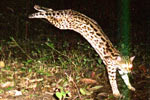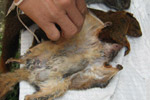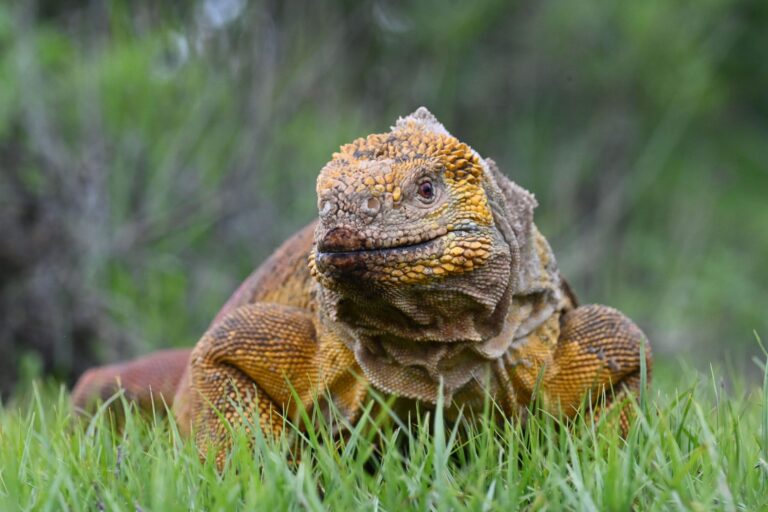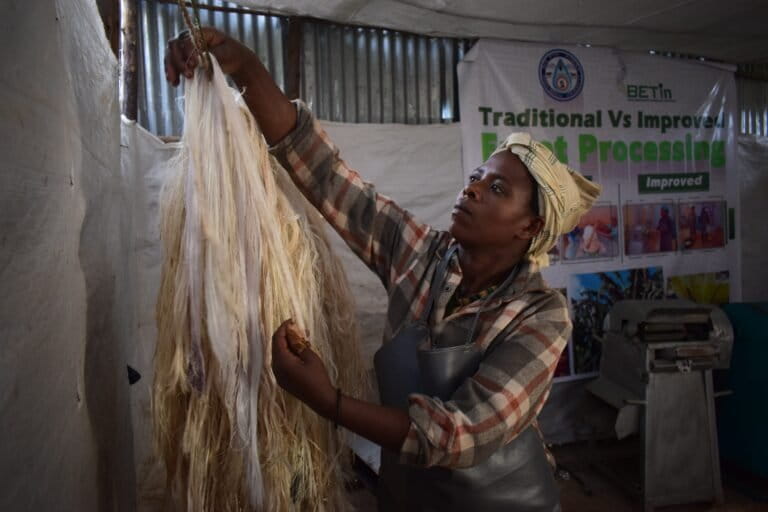
Shell of Margaritifera laosensis specimen from the river Nam Long. Photo by Bolotov et al.
Margaritifera laosensis is the only freshwater pearl mussel species known to inhabit tropical water systems, and is a traditional part of the diet of villagers in Northern Laos. However, the species is listed as Endangered by the IUCN. A study published recently in mongabay.com’s open-access journal Tropical Conservation Science found that the dwindling populations of the bivalve would benefit from a ban on their capture.
“We believe that the most significant threat to Indochinese pearl mussel populations comes from harvest by local people as well as from expansion of agricultural land into stream riparian zones,” the authors write.
The study also identifies threats to M. laosensis from river flow regulation, dam construction and pollution caused by deforestation.
According to Global Forest Watch, the region surrounding many of the sample sites lost 3 percent of its forest cover from 2001 through 2012. The authors write “deforestation and agriculture are leading to increased water pollution in this region,” adding that dams along the Nam Pe and Nam Long rivers cause thick layers of decomposing plant matter to accumulate and no M. laosensis mussels were found in such areas.

The region surrounding many of the team’s sampling sites lost 3 perent of its tree cover from 2001 through 2012. Forest clearing along rivers can lead to bank erosion and affect water quality. Map courtesy of Global Forest Watch. Click to enlarge.

One of the survey sites in the Nam Long River. Photo by Bolotov et al.
The research team surveyed 10 rivers, finding M. laosensis in only two, with low mussel density at each. However, the researchers also found small, young mussels at the sites, indicating the populations are reproductively viable. Previous studies reported one other reproducing population at a site in Vietnam.
“Reproductively viable populations were found only in the Nam Long and Nam Pe rivers, which are two of the only three known viable populations of this species in the world.”
According to the authors, M. laosensis is an umbrella species, in that its protection would also protect other species in its ecological community. The researchers write that protection of these pearl mussels would improve the environmental conditions of their habitat, which is limited to rivers in Northern Laos, Northwestern Vietnam, Northern Thailand and Northeastern Myanmar.
Not only may protection of M. laosensis safeguard other wildlife species in the area, but it may also benefit human communities.
“These changes will bring positive effects to local communities: more clear water for home needs, longer navigation period due to increase of high water level period, and increased fish catch,” write the authors.
Citations:
Bolotov, I.; Vikhrev, I.; Bespalaya, Y.; Artamonova V.; Gofarov M.; Kolosova, J.; Kondakov A.; Makhrov A.; Frolov A.; Tumpeesuwan S.; Lyubas A.; Romanis T.; Titova K. 2014, Ecology and conservation of the endangered Indochinese freshwater pearl mussel, Margaritifera laosensis (Lea, 1863) in the Nam Pe and Nam Long rivers, Northern Laos. Tropical Conservation Science, Vol.7 (4):706-719
Hansen, M. C., P. V. Potapov, R. Moore, M. Hancher, S. A. Turubanova, A. Tyukavina, D. Thau, S. V. Stehman, S. J. Goetz, T. R. Loveland, A. Kommareddy, A. Egorov, L. Chini, C. O. Justice, and J. R. G. Townshend. 2013. “Hansen/UMD/Google/USGS/NASA Tree Cover Loss and Gain Area.” University of Maryland, Google, USGS, and NASA. Accessed through Global Forest Watch on Dec. 23, 2014. www.globalforestwatch.org.Related articles
Saving Asia’s other endangered cats (photos)

(10/21/2014) It’s no secret that when it comes to the wild cats of Asia—and, really, cats in general—tigers get all the press. In fact, tigers—down to an estimated 3,200 individuals—arguably dominate conservation across Asia. But as magnificent, grand, and endangered as the tigers are, there are a number of other felines in the region that are much less studied—and may be just as imperiled.
The largest biosphere reserve in Southeast Asia: Vietnam’s success story or a conservation failure? PART I 
(09/30/2014) In 2010, poachers shot and killed the last Javan rhino in Vietnam, wiping out an entire subspecies. The Sumatran rhino, the Malayan tapir and the civet otter, too, have disappeared from the country. Moreover, charismatic species like tigers, elephants, gibbons and the secretive saola discovered recently in Vietnam’s forests are at risk of extinction in the coming decades as threats to wildlife continue unabated in the country.
NASA: Forest loss leaps in Bolivia, Mekong region (08/08/2014) New satellite data from NASA suggests that deforestation is sharply increasing in Bolivia and Mekong countries during the second quarter of 2014.
Chinese luxury furniture linked to murder, near extinction 
(05/12/2014) Intricately carved, meticulously designed, and costing hundreds of thousands of dollars: this is “hongmu,” or Chinese luxury furniture reflecting the elite styles of the Ming and Qing dynasties. But while the red-colored furniture may be aesthetically beautiful, it comes with a blood price.
Long lost mammal photographed on camera trap in Vietnam 
(03/25/2014) In 1929, two sons of Theodore Roosevelt (Teddy Junior and Kermit) led an expedition that killed a barking deer, or muntjac, in present-day Laos, which has left scientists puzzled for over 80 years. At first scientists believed it to be a distinct species of muntjac and named it Roosevelts’ muntjac (Muntiacus rooseveltorum), however that designation was soon cast into doubt with some scientists claiming it was a specimen of an already-known muntjac or a subspecies. The problem was compounded by the fact that the animal simply disappeared in the wild. No one ever documented a living Roosevelts’ muntjac again—until now.
The smoothtooth blacktip shark and four other species rediscovered in markets 
(01/21/2014) Scientific American) magazine recently ran an article on the rediscovery of the smoothtooth blacktip shark (Carcharhinus leiodon) in a Kuwaiti fish market. Believed extinct for over 100 years, the smoothtooth had not been seen since the naturalist Wilhelm Hein returned from a trip to Yemen in 1902. With its reappearance, scientists scoured Kuwaiti markets and discovered an astounding 47 individual smoothtooth blacktips.
Asia’s ‘unicorn’ photographed in Vietnam 
(11/12/2013) In 1992, scientists made a spectacular discovery: a large, land mammal (200 pounds) that had somehow eluded science even as humans visited the moon and split the atom. Its discoverers, with WWF and Vietnam’s Ministry of Forestry, dubbed the species the saola (Pseudoryx nghetinhensis). Found in the Annamite Mountains in Laos and Vietnam, the saola is a two-horned beautiful bovine that resembles an African antelope and, given its rarity, has been called the Asian unicorn. Since its discovery, scientists have managed to take photos via camera trap of a wild saola (in 1999) and even briefly studied live specimens brought into villages in Laos before they died (in 1996 and again in 2010), however the constant fear of extinction loomed over efforts to save the species. But WWF has announced good news today: a camera trap has taken photos of a saola in an unnamed protected area in Vietnam, the first documentation of the animal in the country in 15 years.
Lao ecotourism project wins responsible travel award for innovation 
(11/11/2013) An ecotourism project in a remote part of Laos has won the prestigious World Responsible Tourism Award for Best for Responsible Wildlife Experience. The Nam Nern Night Safari, an ecotour in Lao PDR’s Nam Et-Phou Louey National Protected Area in Houaphan Province, was recognized by the World Travel Mart for its innovative approach to generating benefits for local communities.
Scientists discover new flying mammal in bushmeat market 
(08/06/2013) The bushmeat markets of Lao PDR (Laos) are filled with racks of wild game harvested both legally and illegally from the surrounding landscapes. While these meat markets certainly provide local protein to patrons, for wildlife biologists they offer something more. These bizarre zoological exhibits are a rich source of information about wildlife populations and wildlife consumption in remote areas.
Mekong region has lost a third of its forests in 30 years, may lose another third by 2030 (05/03/2013) The Greater Mekong region of Cambodia, Laos, Myanmar (Burma), Thailand and Vietnam will lose a third of its remaining forest cover by 2030 unless regional governments improve management of natural resources and transition toward a greener growth model, warns a new report issued by WWF.
The river of plenty: uncovering the secrets of the amazing Mekong 
(04/23/2013) Home to giant catfish and stingrays, feeding over 60 million people, and with the largest abundance of freshwater fish in the world, the Mekong River, and its numerous tributaries, brings food, culture, and life to much of Southeast Asia. Despite this, little is known about the biodiversity and ecosystems of the Mekong, which is second only to the Amazon in terms of freshwater biodiversity. Meanwhile, the river is facing an existential crisis in the form of 77 proposed dams, while population growth, pollution, and development further imperil this understudied, but vast, ecosystem.
Captive frogs may be spreading diseases to wild cousins across Southeast Asia (03/07/2013) Scientists have documented a series of links between exotic frogs for trade and diseases in wild frogs in Southeast Asia, including the first documented case of the chytrid fungus—a virulent and lethal disease—in Singapore. According to researchers writing in a new study in EcoHealth, frogs imported into Southeast Asia as pets, food, or traditional medicine are very likely spreading diseases to wild populations.
Cute animal picture of the day: white-cheeked gibbon baby (01/16/2013) A northern white-cheeked gibbon pair (Nomascus leucogenys) at the Wildlife Conservation Society’s (WCS) Bronx Zoo have given birth to a brand new infant. This is the mother gibbon’s 11th infant.
Mystery surrounds disappearance of prominent environmental activist in Laos (12/23/2012) Questions surrounding the disappearance of 60-year-old Sombath Somphone deepened after the government of Laos denied kidnapping and holding the prominent social activist, reports the Associated Press.
Pictures: 126 new species discovered in Greater Mekong region last year (12/18/2012) Some 126 new species were described in Asia’a Mekong region last year, notes a new report published by the World Wildlife Fund (WWF).
Controversial dam gets approval in Laos (11/07/2012) Laos has given approval to the hugely-controversial $3.5 billion Xayaburi Dam on the Mekong River, reports the BBC. The massive dam, which would provide 95 percent of its energy production to Thailand, has been criticized for anticipated impacts on the river’s fish populations, on which many locals depend.
Corruption still plundering forests in Laos for furniture (09/26/2012) The forests of Lao are still suffering from widespread destruction with the government turning a blind eye to a thriving black market logging trade on the border of Laos and Vietnam, according to an update report by the Environmental Investigation Agency (EIA). Last year, the EIA found that powerful players, including the Vietnamese military, were plundering Laos of its forests for raw logs. Smuggled from Laos into Vietnam, the raw logs are crafted into furniture, which are eventually exported to Europe and the U.S. Now, over a year later a new report finds little has changed.













